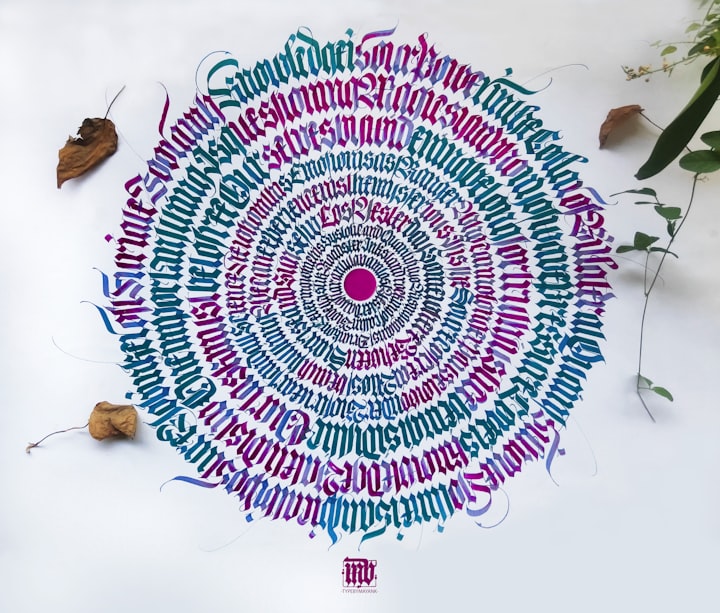
Mandala art is a unique and intricate form of spiritual and ritual art that has a long history and deep cultural significance. Derived from the Sanskrit word for "circle" or "center," mandalas are circular designs that symbolize the cyclical nature of life and the universe. In Hinduism and Buddhism, mandalas have been used as a tool for meditation, spiritual growth, and religious rituals for centuries. Today, mandala art has gained popularity as a form of creative expression, relaxation, and mindfulness practice.
The Origins and Meaning of Mandala Art
The origins of mandala art can be traced back to ancient India, where it was used in Hindu and Buddhist religious rituals and ceremonies. Mandalas were created using sand or colored powders, and they were often temporary, destroyed after the ceremony to symbolize the impermanence of life.
In Hinduism, mandalas were used as a tool for meditation and spiritual growth. They were also used in religious rituals, such as the creation of rangoli patterns on the floor of homes and temples during festivals. These mandalas were created using colored powders or flowers and were meant to represent the divine energy of the gods.
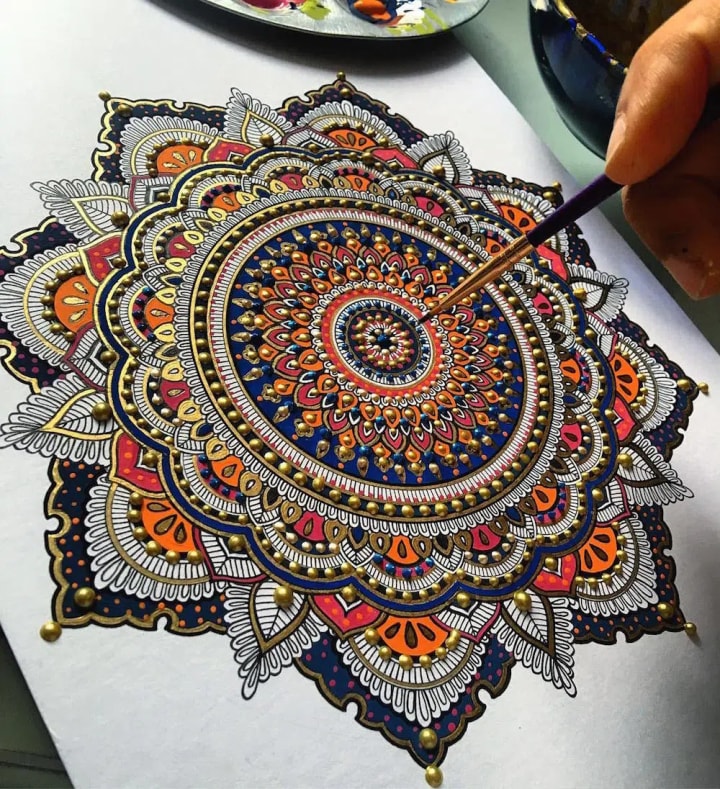
In Buddhism, mandalas were used as a tool for meditation and visualization. Practitioners would focus on the mandala's design and colors to help them achieve a state of inner peace and harmony. Tibetan Buddhist monks are well-known for creating intricate mandalas from colored sand as part of their spiritual practices.
The circular design of mandalas is meant to represent the cyclical nature of life and the cosmos. The center of the mandala is often the starting point, with the design radiating outwards in a series of concentric circles. Mandalas often incorporate geometric shapes, such as circles, squares, triangles, and hexagons, and they often include intricate patterns, symbols, and images.
Mandala Art Today
In recent years, mandala art has gained popularity as a form of creative expression and relaxation. Coloring books featuring mandala designs have become widely available, and many people find that coloring mandalas can be a meditative and calming activity. Mandala art has also become a popular form of artistic expression, with artists creating their own unique mandala designs using a variety of materials and techniques.
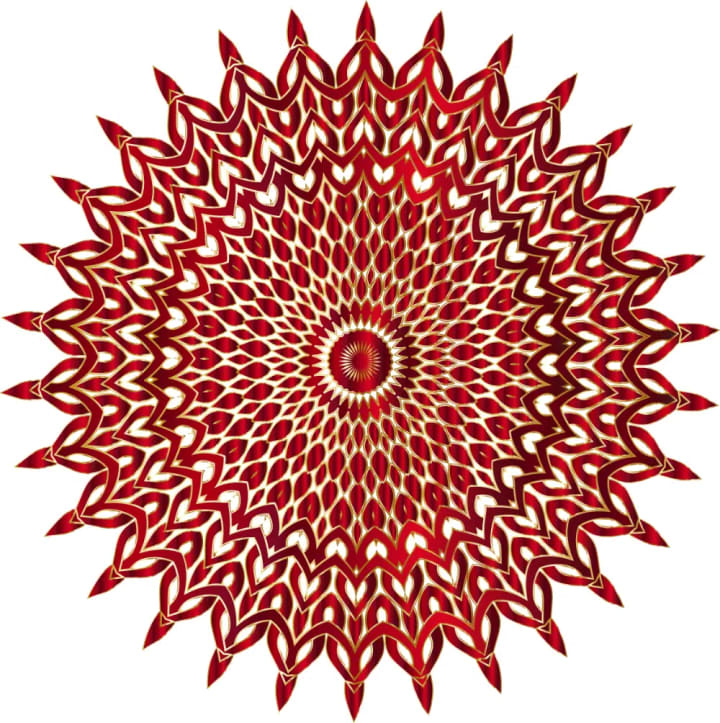
Mandala art is often used as a mindfulness practice, helping practitioners to focus their attention and quiet their minds. By focusing on the intricate patterns and shapes of the mandala, practitioners can achieve a state of relaxation and inner peace. Mandalas can also be used as a tool for self-discovery and personal growth, with each design representing different aspects of the self and the universe.
Types of Mandala Art
There are many different types of mandalas, each with its own unique design and meaning. Here are some of the most common types of mandala art:
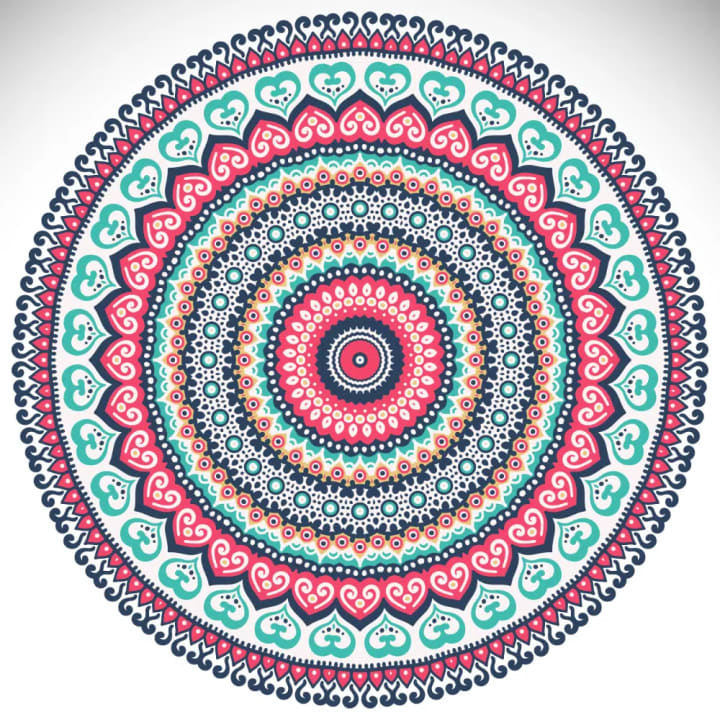
1. Yantra Mandala:
Yantra mandalas are used in Hinduism and Buddhism as a tool for meditation and visualization. They often feature intricate geometric designs and symbols that represent different aspects of the universe and the divine.
2. Sand Mandala:
Sand mandalas are a type of Tibetan Buddhist mandala that is created using colored sand. They are often created as part of religious rituals and ceremonies, and once the mandala is complete, it is destroyed to symbolize the impermanence of life.
3. Medicine Wheel:
Medicine wheels are a type of Native American mandala that represents the cycles of life and nature. They often feature different colors, animals, and elements that represent different aspects of the self and the universe.
4. Chakra Mandala:
Chakra mandalas are used in Hinduism and Buddhism as a tool for meditation and spiritual growth. They represent the seven chakras, or energy centers, of the body, with each chakra represented by a different color and symbol.
5. Celtic Mandala:
Celtic mandalas feature intricate knotwork and interlacing patterns that represent the interconnectedness of all things. They often include images of animals and nature, as well as Celtic symbols and mythology.
Creating Your Own Mandala Art
Creating your own mandala art can be a fun and rewarding experience. You don't need to be an artist to create a beautiful and meaningful mandala design. Here are some tips for getting started:
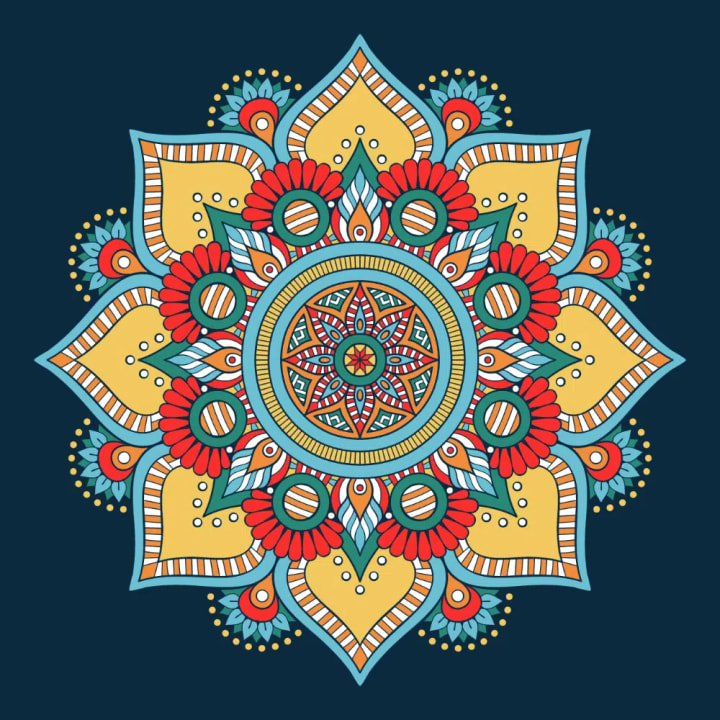
1. Choose your materials:
You can create a mandala using any materials you like, such as colored pencils, markers, paints, or even natural materials like leaves and flowers. Choose materials that inspire you and that you enjoy working with.
2. Start with a circle:
The circle is the foundation of the mandala design. You can use a compass to create a perfect circle, or you can draw a circle freehand.
3. Add geometric shapes:
Once you have your circle, you can start adding geometric shapes to your design, such as triangles, squares, and hexagons. These shapes can be used to create intricate patterns and designs within the circle.
4. Choose your colors:
Color is an important aspect of mandala art. Choose colors that inspire you and that have personal meaning. You can also use color symbolism to represent different aspects of the self and the universe.
5. Add symbols and images:
You can incorporate symbols and images into your mandala design to represent different aspects of the self and the universe. These can include spiritual symbols, animals, nature, or anything else that inspires you.
6. Keep it symmetrical:
Symmetry is an important aspect of mandala art. Try to keep your design symmetrical, with patterns and shapes repeated evenly around the circle.
7. Practice mindfulness:
As you create your mandala, focus on the present moment and the intricate details of your design. Use the process of creating the mandala as a mindfulness practice, helping you to achieve a state of relaxation and inner peace.
Famous Mandala Arts
Mandala art has gained worldwide popularity and has been created by artists and practitioners around the globe. There are many examples of famous mandala art from around the world, spanning different cultures, traditions, and time periods. Here are just a few examples:
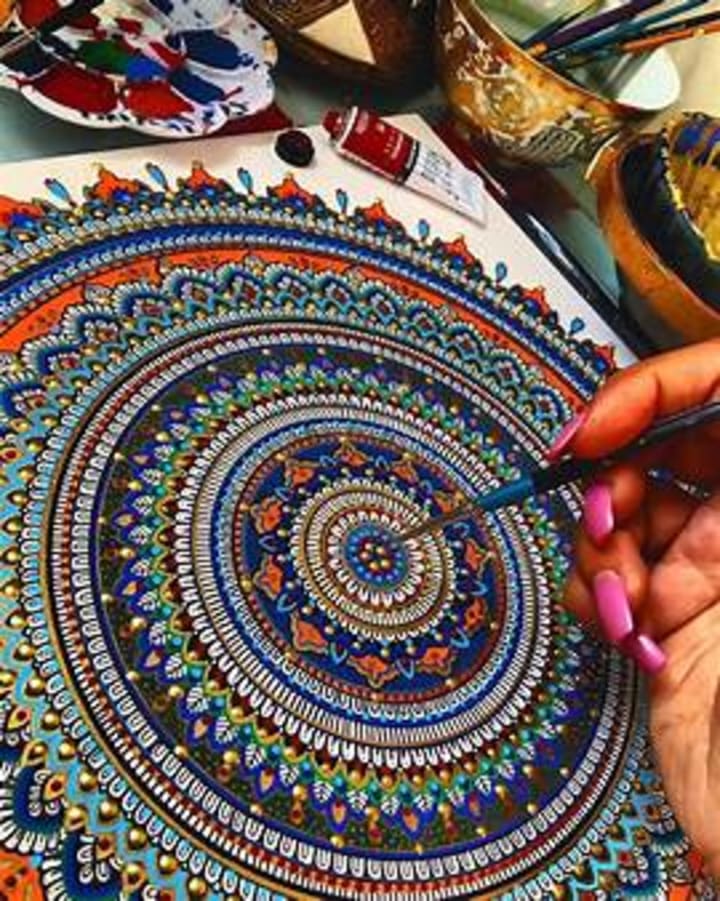
1. The Mandalas of Tibet:
Perhaps the most famous mandalas in the world are the sand mandalas created by Tibetan monks. Tibetan sand mandalas are perhaps the most well-known type of mandala art. These intricate designs are made from colored sand and take many hours to create. The process of creating a sand mandala can take weeks or even months, and the finished design is considered a temporary work of art. They are used as a tool for meditation and spiritual practice and are often destroyed once they are complete, symbolizing the impermanence of all things.
2. The Mandalas of Hinduism:
Hinduism has a long tradition of mandala art, with mandalas featuring prominently in Hindu mythology and religious practice. One famous example is the Sri Yantra mandala, which represents the union of the masculine and feminine energies of the universe. They are often created using colored rice, sand, or flower petals, and can be found in Hindu and Buddhist temples throughout India.
3. The Mandalas of Buddhism:
Buddhism also has a rich tradition of mandala art, with mandalas used as a tool for meditation and spiritual practice. One of the most famous examples is the Mandala of the Five Buddhas, which represents the five elements and the five pearls of wisdom of the Buddha.
4. The Mandalas of Native American Culture:
Many Native American tribes have their own tradition of mandala art, with designs often featuring symbols of nature, animals, and the cosmos. One famous example is the Navajo sand painting, which is used in healing ceremonies and features intricate geometric designs.
5. The Mandalas of Contemporary Art:
In recent years, mandala art has also become popular in contemporary art, with artists incorporating mandala designs into their paintings, sculptures, and installations. One famous example is the work of the artist Anish Kapoor, whose large-scale installations often feature circular shapes and intricate patterns.
6. Australian Aboriginal Mandala Art:
Aboriginal mandalas are known as "Dreaming" or "Songlines" and are used for storytelling and spiritual practice. These intricate designs are often created using sand, bark, or paint, and are inspired by the natural environment and the ancestral spirits of the Aboriginal people.
7. Western Mandala Art:
In recent years, mandala art has become increasingly popular in the West, with artists creating their own unique designs using a variety of materials and techniques. Mandala coloring books have also become a popular trend, allowing people to enjoy the meditative benefits of coloring and creating mandalas without needing any artistic skill or experience.
These are just a few examples of famous mandala art from around the world. The beauty and significance of mandala art have inspired countless artists and practitioners throughout history, and continue to be a source of inspiration and creativity today.
Benifits of Mandala Art
Mandala art is known for its many mental health benefits and has been used as a form of therapy for centuries. Here are some of the mental benefits of mandala art:
Stress Reduction:
Creating or coloring mandalas can be a relaxing and calming activity, helping to reduce stress and anxiety. Focusing on the repetitive patterns and colors of the mandala can help to quiet the mind and promote a sense of peace and relaxation.
Mindfulness and Meditation:
The process of creating or coloring a mandala can be a form of mindfulness practice, helping to promote a sense of presence and awareness in the present moment. Many people use mandalas as a tool for meditation, focusing their attention on the colors and patterns of the mandala to promote a sense of inner peace and clarity.
Self-Expression:
Creating a mandala can be a form of self-expression, allowing individuals to explore their inner thoughts and feelings in a safe and creative way. The colors and patterns of the mandala can represent different aspects of the self, helping individuals to connect with their inner wisdom and intuition.
Improved Concentration:
Creating or coloring a mandala requires concentration and focus, which can help to improve cognitive function and mental clarity. By focusing on the intricate details of the mandala, individuals can improve their ability to concentrate and maintain focus over time.
Increased Self-Awareness:
Mandala art can help individuals to connect with their inner selves, promoting a deeper sense of self-awareness and understanding. By exploring different colors and patterns, individuals can gain insight into their own thoughts, feelings, and emotions, helping them to cultivate a greater sense of self-awareness and acceptance.
Overall, mandala art is a powerful tool for promoting mental health and well-being. Whether you are creating your own mandala designs or coloring in a mandala coloring book, taking the time to engage in this meditative and therapeutic practice can have a profound impact on your mental health and well-being.
Final Thoughts
It is a versatile art form that can be enjoyed by people of all ages and skill levels. By creating a mandala, you can tap into your creativity, explore your inner self, and connect with the world around you.
If you are new to mandala art, start by exploring different types of mandalas and finding inspiration in their patterns, colors, and symbolism. Practice drawing or coloring mandalas and experiment with different materials and techniques to create your own unique designs.
Remember that the process of creating a mandala can be just as rewarding as the final product. Take your time, focus on the present moment, and enjoy the meditative and therapeutic benefits of this beautiful art form.
In addition to creating mandala art, you can also explore other ways to incorporate mandalas into your life. You can use mandalas as a tool for meditation, visualization, and manifestation. You can also use them to decorate your home, as a way to infuse your living space with positive energy and spiritual symbolism.
Overall, mandala art is a powerful and meaningful form of creative expression that can help you connect with your inner self and the world around you. Whether you are creating your own mandala designs or coloring in a mandala coloring book, take the time to appreciate the beauty and significance of this ancient art form
About the Creator
Gokila
She is an astrophile, introvert,
loves to read books all day long,
addicts in healthy lifestyle
and having curiosity to know about new things.
Life Is As Beautiful As You Make It. Contentment Is The Key To Happiness. Peace Be Upon The Saviour.






Comments (1)
Great insight ❤️😉